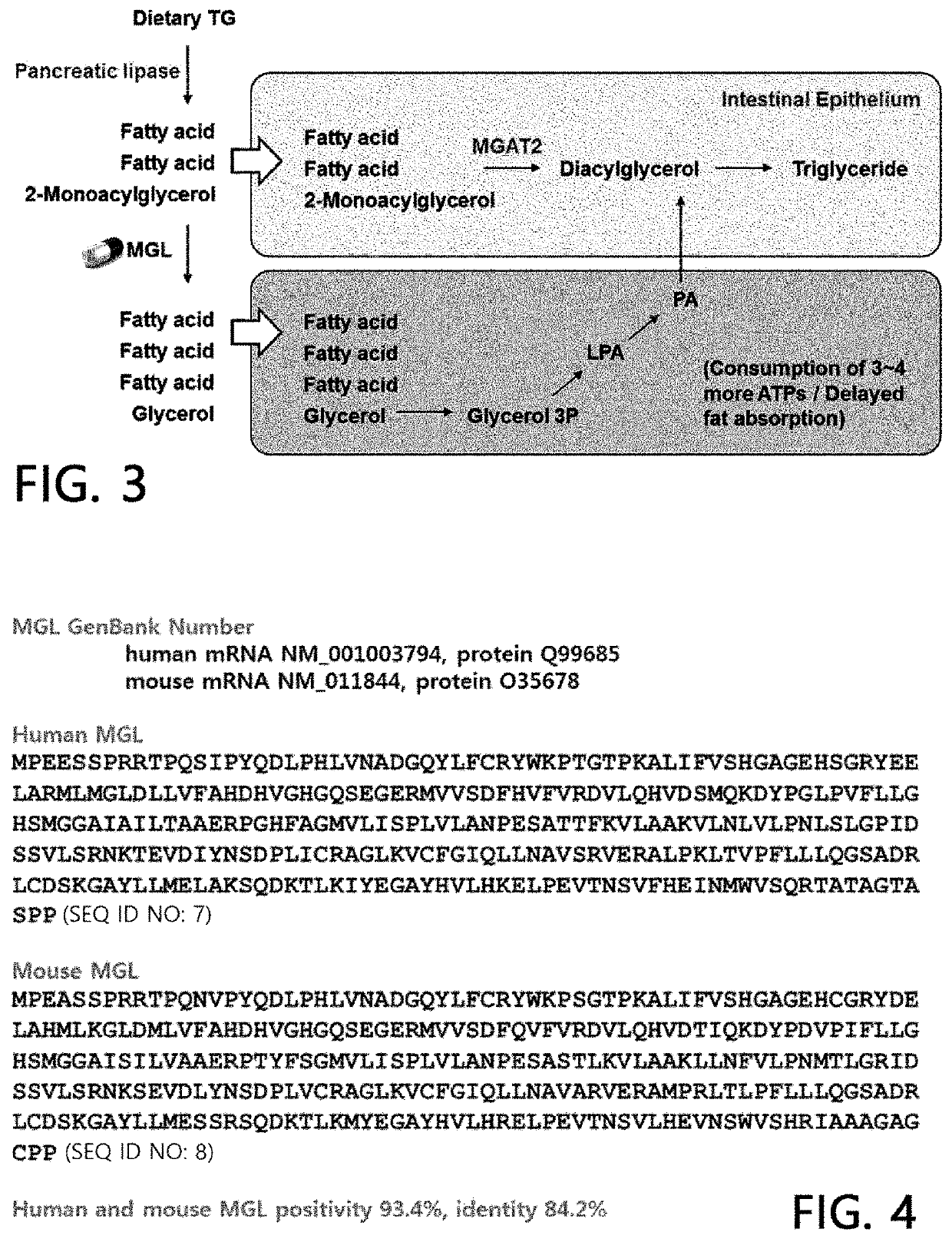Method for treatment of liver steatosis or non-alcoholic fatty liver by using 2-monoacylglycerol cleaving enzyme
a technology of acylglycerol and liver, which is applied in the direction of drug composition, peptide/protein ingredients, metabolic disorders, etc., can solve the imbalance between energy intake and energy use, the most strong threat to the health of modern people, and the side effects of the nervous system
- Summary
- Abstract
- Description
- Claims
- Application Information
AI Technical Summary
Benefits of technology
Problems solved by technology
Method used
Image
Examples
example 1
[0115]Production and Purification of Monoacylglycerol Lipase Protein
[0116]1-1: Production of Recombinant Vector and Recombinant Microorganism
[0117]In the present invention, in order to produce a monoacylglycerol lipase protein, an E. coli system capable of expressing a large amount of protein, and a His-tag were used, in which open reading frame (ORF) portions of the human-derived monoacylglycerol lipase mRNA (Genebank Number: NM 001003794) and the mouse monoacylglycerol lipase mRNA (Genebank Number: NM 011844) were cloned into the pT7-HMT (His-Myc-TEVprotease) vector (Geisbrecht BV et al., Protein Expression Purif 46: 23-32, 2006).
[0118]The pT7-HMT vector is a vector which fuses a six-His tag and a target protein, and allows the resultant to be expressed in bacteria. The pT7-HMT vector has a feature that an expressed protein can be easily purified, and has an advantage that the tag can be removed, as necessary, using a TEV protease.
[0119]First, primers capable of amplifying the ORF...
example 2
Measurement of Activity of Monoacylglycerol Lipase Protein
[0128]In the present invention, in order to measure activity of the mouse-derived monoacylglycerol lipase purified in Example 1, the isolated protein and oleoyl-rac-glycerol (Cat. No. M7765, Sigma, USA) which is a substrate of the isolated protein were reacted with each other, and glycerol liberated thereby was measured using the Glycerol assay kit (Cat. No. MAK117, Sigma, USA) with reference to a manual attached to the kit. 1 unit was defined as an amount such that 1 mole of monoacylglycerol is completely degraded for 1 hour at a condition of pH 7.4 and 37° C. In this method of measuring activity, an amount of activity was calculated with reference to a glycerol standard.
[0129]In addition, a protein concentration was measured using the PierceTM BCA assay kit (Cat. No. 23225, ThermoFisher Scientific, USA). From this, activity per mg was calculated.
[0130]Endotoxins that may remain in the protein were measured using the Pierce™...
example 3
Degradation of 2-Monoacylglycerol and Obesity-Decreasing Effect
[0135]In the present example, an obesity-decreasing effect caused by a 2-monoacylglycerol degradation enzyme was identified. Specifically, a porcine pancreatic lipase (L3126, Sigma, USA) which is a 1,3-specific lipase was used as a control group and a Candida rugosa lipase (L1756, Sigma, USA) was selected as a non-specific lipase. Such lipases were administered into ob / ob mice (Central Lab. Animal Inc., Korea) by gavage for 7 weeks. As a result, as illustrated in FIG. 8, the C. rugosa lipase which is a non-specific lipase exhibited only a slight decrease in body weight as compared with the control group.
PUM
| Property | Measurement | Unit |
|---|---|---|
| body weight | aaaaa | aaaaa |
| pH | aaaaa | aaaaa |
| pH | aaaaa | aaaaa |
Abstract
Description
Claims
Application Information
 Login to View More
Login to View More - R&D
- Intellectual Property
- Life Sciences
- Materials
- Tech Scout
- Unparalleled Data Quality
- Higher Quality Content
- 60% Fewer Hallucinations
Browse by: Latest US Patents, China's latest patents, Technical Efficacy Thesaurus, Application Domain, Technology Topic, Popular Technical Reports.
© 2025 PatSnap. All rights reserved.Legal|Privacy policy|Modern Slavery Act Transparency Statement|Sitemap|About US| Contact US: help@patsnap.com



